Metamorphic rock classification by geologists hinges on texture and composition, especially foliation. Understanding how these rocks are categorized helps homeowners, landscape designers, and rock enthusiasts alike make informed decisions. Rockscapes.net offers a wide selection of these fascinating materials.
1. What Are the Main Types of Metamorphic Rocks Based on Foliation?
Metamorphic rocks are mainly categorized into foliated and non-foliated types based on their texture, which helps determine their use in landscapes. Foliated rocks exhibit a layered or banded appearance due to the alignment of mineral grains under pressure, while non-foliated rocks lack this alignment. According to the Geological Society of America, foliation arises from directed pressure during metamorphism, causing minerals to align perpendicular to the stress. Understanding these differences is crucial when selecting stones for landscape design, as the texture affects both aesthetics and structural properties.
2. How Do Foliated Metamorphic Rocks Differ From Non-Foliated Ones?
Foliated metamorphic rocks have a layered appearance because their mineral grains align during metamorphism, whereas non-foliated rocks do not have this alignment. Foliation occurs when directed pressure causes minerals like mica to align perpendicularly to the stress. Non-foliated rocks typically form under uniform pressure or from parent rocks with blocky minerals like quartz. The presence or absence of foliation greatly influences how these rocks are used in landscaping; for example, slate, a foliated rock, is ideal for creating layered pathways or retaining walls, while marble, a non-foliated rock, is often used for sculptures or decorative accents.
3. What are the Different Types of Foliated Metamorphic Rocks?
The primary types of foliated metamorphic rocks, in order of increasing metamorphic grade, are slate, phyllite, schist, and gneiss, each showing a distinctive texture due to varying levels of heat and pressure.
- Slate: Formed from low-grade metamorphism of shale, slate exhibits a property called slaty cleavage, breaking into flat sheets.
- Phyllite: Similar to slate but heated to higher temperatures, phyllite has larger mica crystals, resulting in a satiny sheen.
- Schist: Formed at higher temperatures and pressures, schist displays mica crystals large enough to see without magnification.
- Gneiss: Forming at the highest pressures and temperatures, gneiss shows minerals separated into distinct color bands.
Each type offers unique aesthetic qualities for landscaping; slate is excellent for pathways, schist can add sparkle to rock gardens, and gneiss provides bold patterns for retaining walls.
4. What is Slate and How is it Used in Landscaping?
Slate, a low-grade foliated metamorphic rock, forms from the metamorphism of shale and is characterized by its tendency to split into flat sheets due to slaty cleavage, making it ideal for various landscaping applications. Its fine-grained composition allows it to be easily cut and shaped, making it suitable for pathways, patios, and retaining walls. The natural, earthy tones of slate can enhance the aesthetic appeal of any outdoor space. For inspiration and to find the perfect slate for your project, visit Rockscapes.net, or visit us at 1151 S Forest Ave, Tempe, AZ 85281, United States.
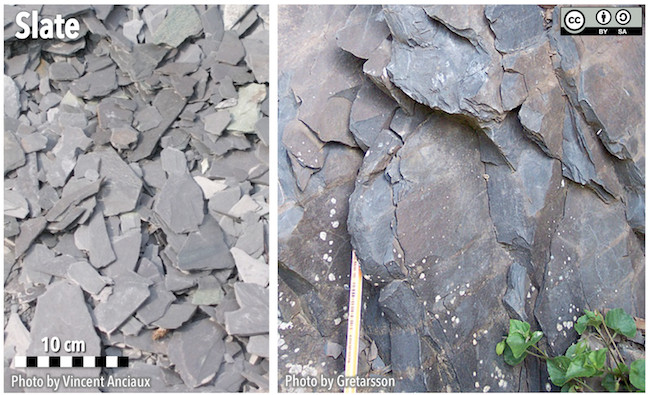 Slate fragments resulting from rock cleavage, ideal for pathways
Slate fragments resulting from rock cleavage, ideal for pathways
5. What Distinguishes Phyllite From Other Foliated Rocks?
Phyllite distinguishes itself from other foliated rocks through its satiny sheen and slightly wavy cleavage, which results from the growth of larger mica crystals at higher temperatures compared to slate. While it resembles slate, the increased temperature during formation causes the mica crystals to grow larger, though still not visible individually. This unique texture makes phyllite a popular choice for decorative stone in landscaping projects. It is often used to add a subtle, shimmering effect to walls or pathways, creating an elegant and refined outdoor space.
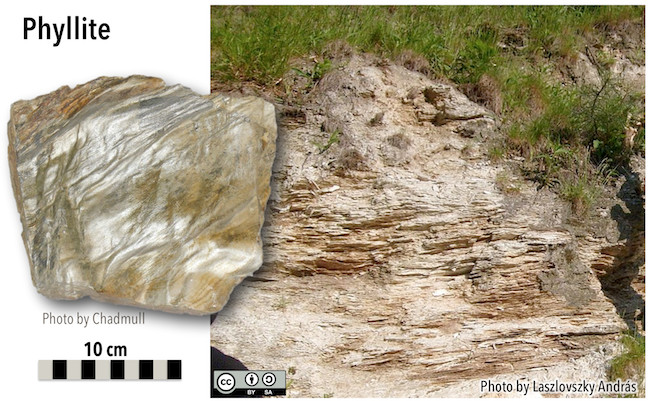 Phyllite hand sample showing a satin texture for decorative use
Phyllite hand sample showing a satin texture for decorative use
6. What Makes Schist a Unique Choice for Landscaping?
Schist stands out as a landscaping material due to its visible mica crystals that sparkle in the light, which are large enough to see without magnification, and form at higher temperatures and pressures. Its unique crystalline structure, often containing other visible minerals like garnet, adds a distinct, shimmering effect to any landscape. Schist is particularly well-suited for rock gardens or accent features where its reflective properties can be fully appreciated. Rockscapes.net offers a diverse selection of schist that can bring a touch of elegance and natural beauty to your outdoor space.
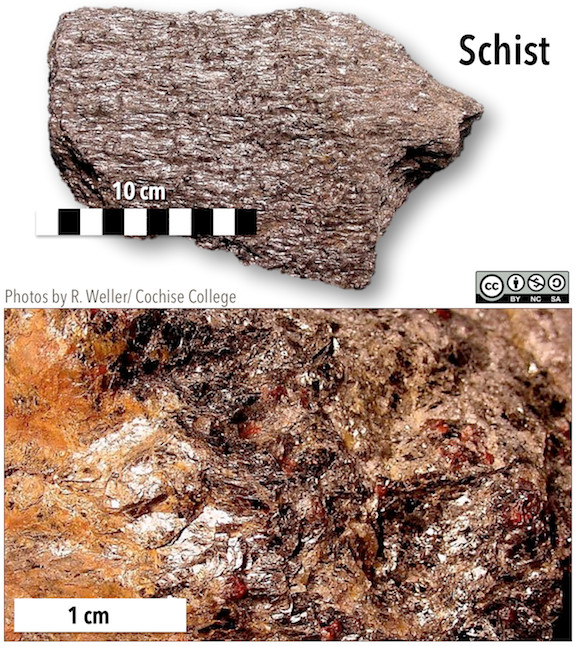 Schist hand sample displaying mica crystals for rock gardens
Schist hand sample displaying mica crystals for rock gardens
7. How is Gneiss Identified and Used in Outdoor Designs?
Gneiss, a high-grade metamorphic rock, is identified by its distinct color bands and large crystals, making it an excellent choice for adding visual interest to outdoor designs. Formed under intense pressure and temperature, its minerals separate into bands of different colors, typically dark bands of amphibole and light bands of feldspar and quartz. Gneiss is commonly used in retaining walls, pathways, and as a striking element in water features, bringing texture and color to any landscape. Rockscapes.net offers various gneiss options to enhance your outdoor projects; contact us at +1 (480) 965-9011 for more details.
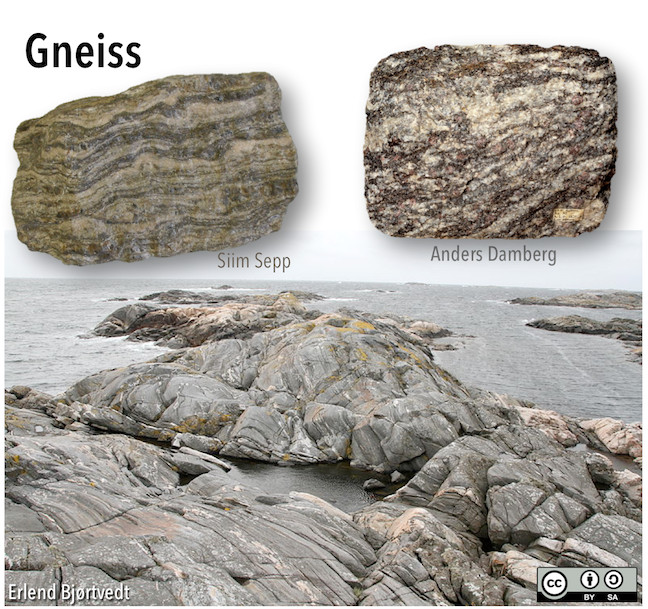 Gneiss hand sample showing color bands for visual interest
Gneiss hand sample showing color bands for visual interest
8. What Are the Main Types of Non-Foliated Metamorphic Rocks?
The main types of non-foliated metamorphic rocks include marble, quartzite, and hornfels, each characterized by a lack of aligned mineral grains and unique formation processes. These rocks typically form under low-pressure conditions or uniform pressure, often due to contact metamorphism near magma intrusions. Their non-layered appearance makes them ideal for different applications in construction and landscaping.
9. Why is Marble a Popular Choice for Landscape Features?
Marble, a non-foliated metamorphic rock derived from limestone, is a popular choice for landscape features due to its recrystallized calcite crystals and attractive appearance, which enhance outdoor aesthetics. The recrystallization process eliminates any original sedimentary textures and fossils, resulting in a uniform, elegant look. Marble’s purity determines its color; pure calcite marble is white, while impurities can create a marbled effect. It’s often used for sculptures, decorative stones, and paving, adding a touch of sophistication to gardens and outdoor spaces. Rockscapes.net offers a variety of marble options perfect for transforming your landscape into a work of art; explore our selection to find the ideal marble for your next project.
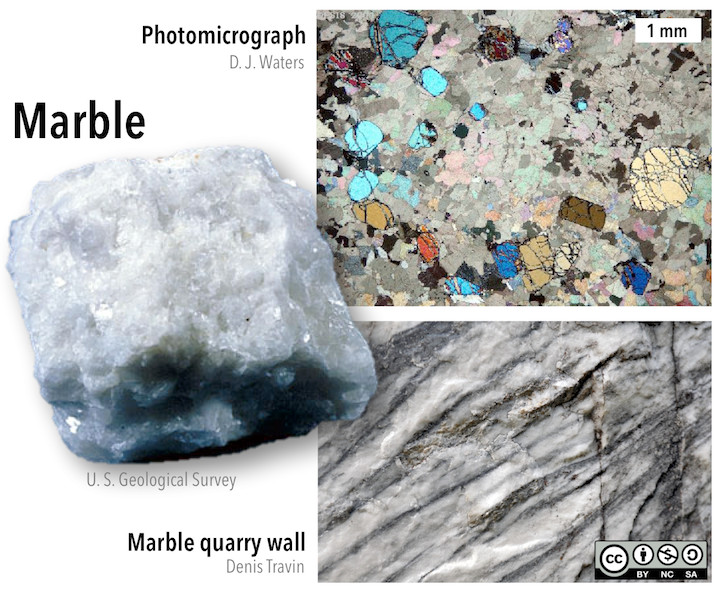 Marble made of pure calcite is white and used for landscape features
Marble made of pure calcite is white and used for landscape features
10. How Does Quartzite Differ From Other Metamorphic Rocks in Landscaping?
Quartzite, a non-foliated metamorphic rock derived from sandstone, differs from other metamorphic rocks due to its hardness and resistance to weathering, making it exceptionally durable for landscaping applications. Composed predominantly of quartz, its grains are welded together with additional silica during metamorphism, creating a robust material. Unlike foliated rocks, quartzite lacks distinct layers, providing a more uniform appearance. This makes it ideal for pathways, retaining walls, and decorative rock features, offering both longevity and natural beauty.
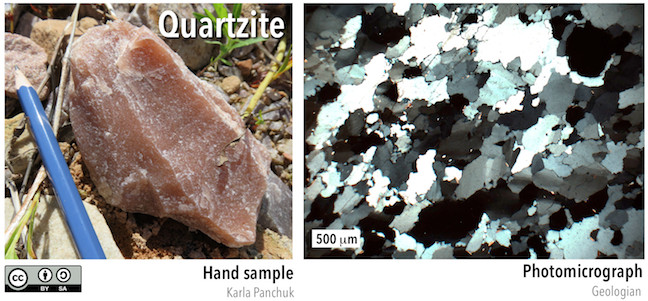 Quartzite from the Baraboo Range, Wisconsin showing its use in landscaping
Quartzite from the Baraboo Range, Wisconsin showing its use in landscaping
11. What are the Distinctive Characteristics of Hornfels?
Hornfels, a non-foliated metamorphic rock, is characterized by its formation during contact metamorphism of fine-grained rocks like mudstone or volcanic rocks, resulting in a dense, tough material with randomly oriented crystals. Unlike foliated rocks, hornfels does not exhibit aligned mineral grains because it forms under conditions where pressure is equal in all directions. Its composition varies based on the parent rock and metamorphic conditions, often containing minerals like micas, pyroxene, and amphibole. This rock is highly valued in landscaping for its unique textural and visual properties, often used as decorative stones or in garden features.
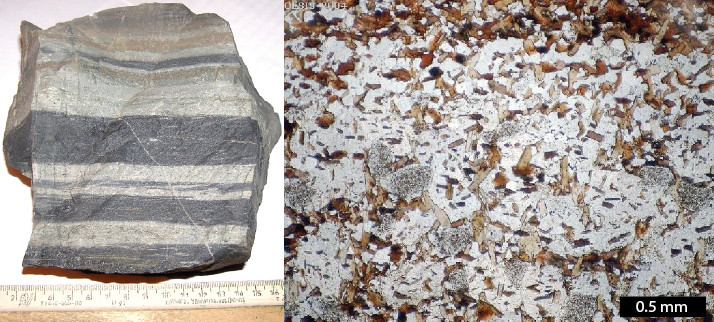 Hornfels from the Novosibirsk region of Russia from a sedimentary protolith showing the layering
Hornfels from the Novosibirsk region of Russia from a sedimentary protolith showing the layering
12. How Does the Parent Rock Influence Metamorphic Rock Formation?
The parent rock, or protolith, profoundly influences the types of metamorphic rocks that can form under different conditions of temperature, pressure, and fluid presence. For instance, mudrock can transform into slate, phyllite, schist, and gneiss as metamorphic grade increases. Rocks like granite and limestone undergo less dramatic changes, becoming gneiss and marble, respectively, due to their stable mineral compositions.
13. What Transformations Occur When Mudrock Undergoes Metamorphism?
When mudrock undergoes metamorphism, it can transform into a series of foliated rocks—slate, phyllite, schist, and gneiss—depending on the intensity of temperature and pressure, with distinct mineralogical changes occurring at each stage.
14. How Does Granite Change During Low-Grade Metamorphism?
Granite, an igneous rock, experiences minimal changes during low-grade metamorphism because its minerals remain stable at temperatures up to several hundred degrees, resulting in little alteration of its original composition or texture.
15. What Happens to Sandstone and Limestone During Metamorphism?
During metamorphism, sandstone and limestone undergo recrystallization, transforming into quartzite and marble, respectively, with larger crystal formations but without significant changes in mineral composition.
16. What is Migmatite and How Does it Bridge Metamorphic and Igneous Processes?
Migmatite is a unique rock that bridges metamorphic and igneous processes, forming when a metamorphic rock undergoes partial melting, resulting in a mixture of light-colored igneous rock and dark-colored metamorphic rock.
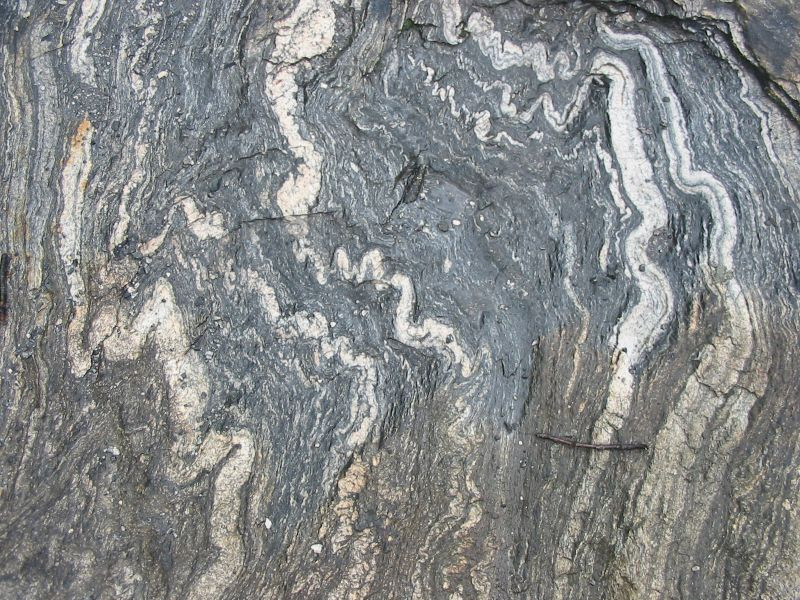 Migmatite photographed near Geirangerfjord in Norway displaying mixed rock
Migmatite photographed near Geirangerfjord in Norway displaying mixed rock
17. What Causes Ptygmatic Folding in Migmatites?
Ptygmatic folding in migmatites occurs when a stiff layer within the rock is surrounded by weaker layers, causing the stiff layer to buckle and fold under pressure while the surrounding rock flows around it.
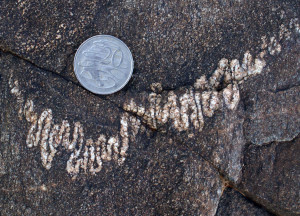 Ptygmatic folding from Broken Hill, New South Wales, Australia showing folding
Ptygmatic folding from Broken Hill, New South Wales, Australia showing folding
18. How Can Amphibolite be Distinguished From Other Metamorphic Rocks?
Amphibolite is distinguished by its composition, dominated by aligned crystals of amphibole, often derived from the metamorphism of mafic igneous rocks. It typically features green hornblende and colorless plagioclase feldspar, with a noticeable horizontal crystal alignment. This alignment and mineral composition set it apart from other metamorphic rocks.
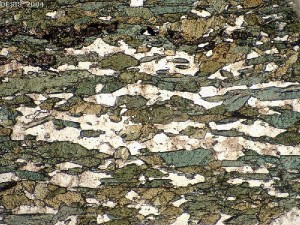 Amphibolite in thin section shows green crystals
Amphibolite in thin section shows green crystals
19. What Factors Determine the Metamorphic Grade of a Rock?
The metamorphic grade of a rock is determined by the temperature, pressure, and fluid conditions to which it is subjected, with higher grades indicating more intense metamorphism and significant changes in mineral composition and texture.
20. How Can Rockscapes.net Help with Metamorphic Rock Selection for Landscaping?
Rockscapes.net offers expert guidance and a diverse selection of metamorphic rocks, ensuring you find the perfect materials to enhance the beauty and functionality of your landscape. Whether you need slate for pathways, marble for decorative features, or gneiss for retaining walls, Rockscapes.net provides detailed information and high-quality products to meet your specific needs. Contact us today at +1 (480) 965-9011 or visit our location at 1151 S Forest Ave, Tempe, AZ 85281, United States, and let our experts help you create the landscape of your dreams.
Enhance Your Landscape with Stunning Metamorphic Rocks!
Ready to transform your outdoor space with the timeless beauty and durability of metamorphic rocks? Visit Rockscapes.net today for inspiration, detailed product information, and expert advice on selecting the perfect stones for your project. Explore our extensive collection and let us help you bring your landscaping vision to life!
Frequently Asked Questions (FAQ)
1. How Do Geologists Classify Metamorphic Rocks?
Geologists classify metamorphic rocks primarily by their texture (foliated or non-foliated) and mineral composition, which reflect the conditions under which they were formed.
2. What is the difference between foliated and non-foliated metamorphic rocks?
Foliated rocks have a layered or banded appearance due to aligned mineral grains, while non-foliated rocks lack this alignment.
3. What are some examples of foliated metamorphic rocks?
Examples of foliated rocks include slate, phyllite, schist, and gneiss, each characterized by different grades of metamorphism and mineral alignment.
4. What are some examples of non-foliated metamorphic rocks?
Non-foliated rocks include marble, quartzite, and hornfels, which lack a layered appearance and form under uniform pressure conditions.
5. How does the parent rock affect the type of metamorphic rock formed?
The parent rock’s composition determines the potential metamorphic rocks that can form under different temperature and pressure conditions; for example, mudrock can become slate, phyllite, schist, or gneiss.
6. What is metamorphic grade?
Metamorphic grade refers to the intensity of temperature and pressure conditions during metamorphism, influencing the mineralogical and textural changes in the rock.
7. What are common uses of metamorphic rocks in landscaping?
Metamorphic rocks are used for various landscaping purposes, including pathways, retaining walls, decorative stones, and sculptures, each offering unique aesthetic and functional benefits.
8. How does contact metamorphism differ from regional metamorphism?
Contact metamorphism occurs when rocks are heated by nearby magma intrusions, while regional metamorphism involves large-scale changes due to tectonic forces and deep burial.
9. What is the significance of mineral alignment in foliated metamorphic rocks?
Mineral alignment in foliated rocks indicates the direction of stress during metamorphism and contributes to the rock’s characteristic layered appearance and structural properties.
10. Where can I find high-quality metamorphic rocks for my landscaping project?
High-quality metamorphic rocks can be sourced from rockscapes.net, a trusted supplier offering a wide selection of materials and expert guidance for all your landscaping needs.